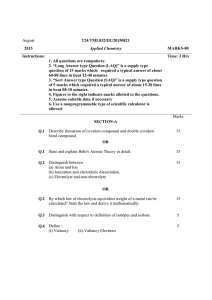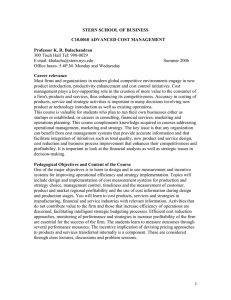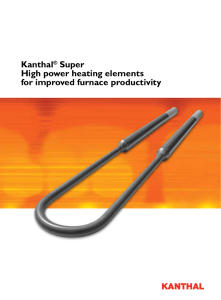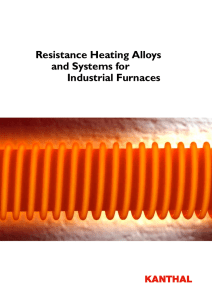Resistance heating alloys and systems for industrial furnaces
advertisement
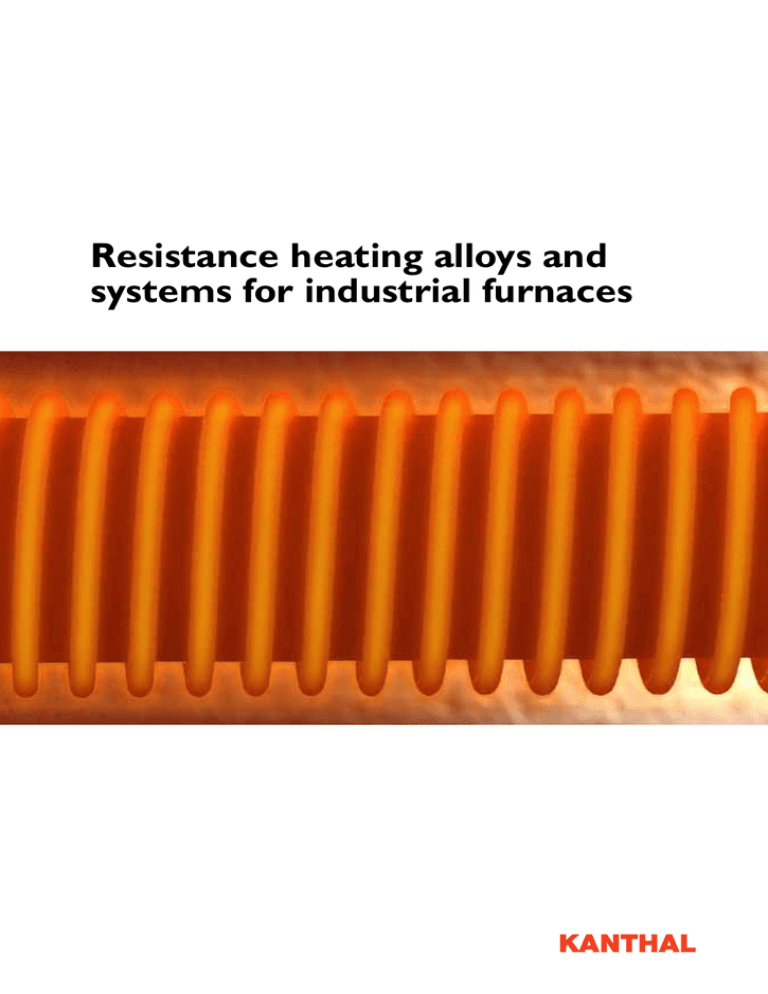
Resistance heating alloys and systems for industrial furnaces Content Metallic heating elements from Sandvik4 Kanthal or Nikrothal?5 Kanthal APM™ heating material6 The great advantages of Kanthal APM are 6 Physical and mechanical properties7 Element surface load8 Operating life and maximum permissible temperature 10 Use Kanthal alloys 10 Avoid temperature fluctuations 10 Choose thick element material 10 Adjust the element temperature to the furnace atmosphere 11 Avoid corrosion from solid substances, fluids and gases 11 Key data for Kanthal elements 12 Tubothal – the most powerful metallic element system 14 High power output 15 Power supply 15 Tables, standard dimensions 17 Kanthal® A-1 and Kanthal APM™ 17 Kanthal® AF 18 Kanthal® D 19 Nikrothal 80 20 Nikrothal 70 21 Bars 22 ® ® ® ® Metallic heating elements from Sandvik This booklet contains technical information for our resistance heating alloys Kanthal® and Nikrothal®. We also include some instructions for the calculation and design of heating elements for industrial furnaces as well as examples of support systems and insulation. The latest product- and application information will be found on www.kanthal.com. We can assist you: • in choosing suitable element material, element type, support system and insulation • by supplying complete heating elements ready for installation • in upgrading both electrical and gas heated furnaces by delivering technical solutions based on latest material technology rendering maximum productivity and economy Our modern workshops have developed considerable experience in manufacturing heating elements and can manufacture to any specifications. Our delivery times are short and our service objectives are high. To get in contact with you local representative for further information visit www.kanthal.com or show this QR-code to your smartphone. 4 Kanthal or Nikrothal ? There are two main types of electric resistance alloys. Nickel-chromium (e.g. 80 Ni, 20 Cr) called Nikrothal was developed around the beginning of the 20th century and was soon used as heating element material in industrial furnaces as well as in electric household appliances. In the thirties AB Kanthal introduced a new resistance heating alloy (called Kanthal) based on ironchromium-aluminium with a longer life and a higher maximum operating temperature than nickelchromium. Kanthal manufactures both types of alloys under the names Nikrothal (nickel-chromium) and Kanthal (iron-chromium-aluminium). The two main types of alloys have their own specific properties, with advantages and disadvantages, and are supplied in many different grades and forms. In general Kanthal type alloy is superior to Nikrothal in respect of performance and life and is therefore nowadays a standard material choice when it comes to metallic heating elements for industrial furnaces. The Nikrothal alloy may have special advantages if you need a heating element having very good The most important advantages with Kanthal type alloy are: •Higher maximum temperature of 1425°C compared to 1250°C for Nikrothal •Up to four times longer life •Higher surface load • Higher resistivity • Lower density •No spalling oxide, which may contaminate the goods and the furnace and also cause short circuit or failure of elements and gas burners mechanical properties in the hot state. Kanthal APM™ has, however, creep strength at elevated temperatures in the same level as Nikrothal. For the furnace user, using Kanthal results in less amount of element material and also a longer life. The table below shows an example of weight saving obtained by using Kanthal instead of nickelchromium alloys. This lower element weight will also result in considerable cost savings regarding support system, because fewer suspension hooks are necessary. A 120 kW furnace equipped with ROB elements. Three elements of 40 kW each, 380 V Element data Nikrothal® Kanthal® Furnace temperature, °C 1000 1000 Element temperature, °C 1068 1106 Hot resistance, Rw 3.61 3.61 Temperature factor, Ct 1.05 1.06 Cold resistance, R20 3.44 3.41 Wire diameter, mm 5.5 5.5 Surface load, W/cm2 3.09 3.98 Wire length 3 elements, m 224.9 174.6 Wire weight 3 elements, kg 44.4 29.6 Weight saving based on same wire diameter: kg: 44.4 – 29.6 = 33 % 44.4 5 Kanthal APM™ heating material Kanthal APM™ is a resistance material which can be used to improve the performance at high temperatures, where conventional metallic elements are getting problems like bunching, creeping, oxide spallation and to open up new applications where metallic elements are not used today. Creep rupture strength for industrial wire 4 mm The great advantages of Kanthal APM are: Improved hot strength, giving: • much better form stability of the heating element • less need for element support • low resistance change (ageing) • longer element life Time, h Temperature 1000°C, MPa 100 5.6 1000 3.4 10000 2.2 Time, h Temperature 1200°C, MPa 100 3.3 1000 1.6 10000 0.7 Excellent oxide, giving: • good protection in most atmospheres, especially corrosive atmospheres • no scaling and impurities • a longer element life Comparison between Kanthal APM (left) and conventional FeCrAl (right) after 1250 h at max 1225°C (2240°F) element temperature. Time, h Temperature 1400°C, MPa 100 1.3 1000 0.5 10000 0.2 Elongation at 1300°C element temperature Sagging test diameter 9.5 mm, 1300°C and 1400°C, 300 mm between supports Elongation, % Sagging, mm 15 30 1400°C 1300°C 10 20 5 10 0 - 5 1400°C 0 100200300400500600 Time, h Kanthal APM™ 6 Kanthal® A-1 0 1300°C 0 50 100150 Time, h Kanthal APM™ Kanthal® A-1 Physical and mechanical properties Kanthal® and Nikrothal® alloys are generally available in wire, ribbon or strip form. Physical and mechanical properties of the alloys are listed in the table below. Ct factor see page 17 and following. Kanthal and Nikrothal basic data Kanthal Max continuous operating temp. °C Nominal composition, % Kanthal® Nikrothal® APM™ A-1 AF D 80 70 60 40 1425 1400 1300 1300 1200 1250 1150 1100 Cr 22 22 22 22 20 30 15 20 Al 5.8 5.8 5.3 4.8 – – – – Fe balance balance balance balance – 5% balance balance Ni – – – – balance balance 60 35 Resistivity at 20°C, Ωmm-2m-1 1.45 Density, g/cm3 7.10 1.45 1.39 7.10 1.35 7.15 1.09 7.25 1.18 8.3 1.11 8.1 1.04 8.2 7.9 Coefficient of thermal 20–750°C 14 × 10 14 × 10 14 × 10 14 × 10 16 × 10 16 × 10 16 × 10 18 × 10-6 20–1000°C 15 × 10-6 15 × 10-6 15 × 10-6 15 × 10-6 17 × 10-6 17 × 10-6 17 × 10-6 19 × 10-6 expansion, K-1 -6 Thermal conductivity at 20°C, W m-1 K-1 -6 -6 -6 -6 -6 -6 13 13 13 13 15 13 13 13 Specific heat capacity at 20°C, KJ kg-1 K-1 0.46 0.46 0.46 0.46 0.46 0.46 0.46 0.50 Melting point, °C 1500 1500 1500 1500 1400 1380 1390 1390 Tensile strength, N mm-2 680 680 680 650 810 820 730 675 Yield point, N mm-2 470 475 475 450 420 430 370 340 Hardness, Hv 230 230 230 230 180 185 180 180 Elongation at rupture, % 20 18 18 18 30 30 35 35 Tensile strength at 900°C, N mm-2 40 34 37 34 100 120 100 120 Creep strength at 800°C at 1000°C 11 3.4 6 1 8 1.5 6 1 15 4 15 4 15 4 20 4 non non slightly non 0.88 0.88 0.88 0.88 Mechanical properties (approx.)* Magnetic properties Emissivity, fully oxidized condition magnetic (curie point 600°C) 0.70 0.70 0.70 0.70 * The values given apply for wire sizes of 4 mm diameter for the Kanthal alloys and of 1 mm for the Nikrothal alloys 7 Element surface load Since Kanthal® alloys can be operated at higher temperatures than Nikrothal® alloys, a higher surface load can be accepted without jeopardizing element life. Element design is also of great importance. The more freely radiating the element form, the higher the maximum surface load can be. Therefore the ROB (rod over bend) type element (corrugated heavy wire, mounted on the surface), can be loaded the highest, followed by the corrugated strip element. Coil elements on ceramic tubes can be loaded higher than coil elements in grooves. The values in the diagrams on page 9 are given for the following design conditions: 8 Maximum recommended loop length: < 900°C 300 mm 1000°C 250 mm 1100°C 200 mm 1200°C 150 mm 1300°C 100 mm For finer wire diameters and smaller strip thicknesses lower surface loads and shorter loop lengths must be chosen to avoid element deformation and subsequent shorter element life. Element type c: Wire element on ceramic tube. Wire diameter minimum 3 mm. Element types a (heavy wire) and b (strip): Element type d: Strip thickness minimum 2.5 mm. Wire diameter minimum 5 mm. Pitch minimum 50 mm at maximum loop length and maximum surface load. Wire and strip element in grooves. Wire diameter minimum 3 mm, strip thickness minimum 2 mm. Note: s = (2 – 3) d s = (3 – 6) d The diagrams are valid for thyristor control. For on-off control lower surface loads should be chosen (about - 20%). D= (10 – 14) d D= (5 – 8) d d d Maximum recommended surface loads for Kanthal A-1, Kanthal AF and Kanthal APM alloys in industrial furnaces Surface load, W/cm2 12 10 9 8 7 6 5 4 3 2 1 800 850 900 950 1000 10501100115012001250 1300 Furnace temperature, °C Maximum recommended surface loads for Nikrothal alloys in industrial furnaces Surface load, W/cm2 12 reely radiating corrugated wire F elements reely radiating corrugated strip F elements 8 Spiral elements on ceramic tubes 7 Heating elements in grooves 10 9 6 5 4 3 2 1 800 850 900 950 1000 10501100 Furnace temperature, °C 9 Operating life and maximum permissible temperature When heated, resistance heating alloys form an oxide layer on their surface, which prevents further oxidation of the material. To accomplish this function the oxide layer must be dense and resist the diffusion of gases. It must also be thin and adhere to the metal under temperature fluctuations. Use Kanthal alloys In these respects the aluminium oxide formed on Kanthal® alloys is even better than the oxide formed on Nikrothal® alloys, which contributes to the much longer operating life of Kanthal heating elements. The diagram below shows the comparative element life. The operating life of the heating elements will be reduced by rapid temperature fluctuations. It is therefore advisable to choose an electric control equipment, which gives as even a temperature as possible, e.g. by using thyristors. In this chapter you will find some general advice to obtain as long element life as possible. The material thickness has a direct relationship to the element life, in that, as the wire diameter is Heating elements made of Kanthal alloys have up to four times longer life than heating elements made of nickel-chromium material. The higher the temperature, the greater the difference. Avoid temperature fluctuations Choose thick element material Comparative life (Kanthal A-1 at 1200°C = 100%) % 500 400 300 200 100 10001050 110011501200 1250130013501400 Element temperature, °C Kanthal APM™ 10 Kanthal® AF Kanthal A-1 Kanthal D Nikrothal® 80 Nikrothal 60 Nikrothal 40 increased, more alloying element is available per surface unit to form a new oxide. Thus, at given temperature, thicker wires will give a longer life than thinner wires. Accordingly, for strip elements, increased thickness gives a longer life. As a general rule, we recommend minimum 3 mm wire diameter and 2 mm strip thickness. Adjust the element temperature to the furnace atmosphere The table shows some common furnace atmospheres and their influence on the maximum operating temperature of the heating elements. Nikrothal should not be used in furnaces having a CO-containing protective gas atmosphere due to the risk of “green rot” at 800– 950°C. heating elements should be carried out at regular intervals. Avoid corrosion from solid substances, fluids and gases Impurities in the furnace atmosphere, for instance oil, dust, volatiles or carbon deposits can damage the heating elements. Sulphur is harmful to all nickel alloys. Chlorine in different forms will attack both Kanthal and Nikrothal alloys. Splashes of molten metal or salt may also damage the heating elements. In such cases Kanthal alloys are recommended, provided the heating elements are preoxidized in air at 1050°C for 7– 10 hours. Reoxidation of the Maximum permissible temperatures in various atmospheres Kanthal® A-1 and Kanthal AF Kanthal D Kanthal APM™ °C °C °C Nikrothal® 80 and 70 °C Nikrothal 60 °C Nikrothal 40 °C Oxidizing: Air, dry 1400a) 1300 1300 1200d) 1150 1100 Air, moist 1200 1200 1200 1150 1100 1050 Neutral: N2, Nitrogenb) 1200 1250 1150 1250 1200 1150 Ar, Argon 1400 1300 1300 1250 1200 1150 1150 1150 1100 1100c) 1100 1100 Endothermic: 20 CO, 40 H2, 40 N2 1050 1050 1000 1100c) 1100 1100 H2, Hydrogen 1400 1300 1300 1250 1200 1150 a) Exothermic: 10 CO, 15 H2, 5 CO2, 70 N2 Reducing: a) Cracked ammonia : 75 H2, 25 N2 1200 1200 1100 1250 1200 1150 Vacuum: 10-3 dry 1150 1200 1100 1000 900 900 e) a) Max 1425°C for Kanthal APM b) The higher values apply for preoxidized material c) Please note risk of “green rot” formation in carburizing atmospheres. Use Kanthal AF or Nikrothal 70 d) 1250°C for Nikrothal 70 e) An atmosphere created by cracked ammonia, that contains uncracked ammonia, will lower the max. permissible temperature 11 Key data for Kanthal® elements Wire elements Element systems Spiral Spiral Porcupine Rod over bend Supports Ceramic tubes Grooves Ceramic tubes Metallic rods Material Sillimanite Chamotte grade 28 Sillimanite Kanthal APM™ 1300 1250 800 1300 Max. wall loading at 1000°C furnace temperature, kW/m2 40 35 – 50 Max. surface load at 1000°C furnace temperature, W/cm2 3 – 4 3 – 4 – 5 – 6 Wire diameter, d, mm 2.0 – 6,5 2.0 – 5.0 1.0 – 6.5 ≥ 5.0 Strip thickness, t, mm – – – – Strip width, w, mm (in) – – – – Outer coil diameter, D, mm 12 – 14 d 5 – 6 d – – Max. loop length at 1000°C furnace temperature, mm – – – 250 3d 2d 3d 40 Max. furnace temperature, °C Min. pitch at max. loop length, mm 12 Strip elements Corrugated Looped Deep-corrugated Deep-corrugated Deep-corrugated Metallic staples Ceramic tubes U-shaped Kanthal® nails Sillimanite Cordierite or mullite 1300 1300 50 Ceramic cup locks Ceramic bushes Corrugated Ceramic tubes Grooves Cordierite or mullite Sillimanite Chamotte grade 28 1300 1300 1300 1300 60 60 60 60 20–40 3–6 5–6 5–6 5–6 5–6 3–4 2.0 – 5.0 ≥ 5.0 – – – – – – 2.0–3.0 2.0–3.0 2.0–3.0 1.5–3.0 – – 8–12 t 8–12 t 8–12 t 8–12 t – – – – – – 100 250 250 250 250 2–3 w 40 40 50 50 50 1.5 w 13 Tubothal® – the most powerful metallic element system Tubothal® is an ideal electric element used in combination with powder metallurgy tubes because of its great advantages, such as – very high power – long life – low weight – easy to design to existing power controls and supply. Combined with Kanthal APM™ tubes, a “maintenance free system” is obtained with high reliability and with no need to remove elements, clean or rotate tubes, if correctly designed. The variety of applications where the Tubothal system can be used is vast. The main areas of use are in heat treatment, aluminium and steel industry furnaces. The high loading capabilities of both Tubothal elements and Kanthal APM tubes can be exploited to the full in new furnaces and conversions from traditional radiant tube designs. In both cases, higher power and/or higher temperatures can be obtained, or a similar output can be achieved with fewer assemblies installed, leading to improved furnace flexibility and lower costs. The longer life obtained with the Tubothal system, ensures highly reliable production and uninterrupted furnace operation. Tubothal element assemblies are available in a wide range of standard diameters, to suit the sizes of tubes currently available. In principle, the length of element is virtually unlimited, but the practicalities of packing, shipping and installation may impose restrictions on the usable length. Tubothal elements are suitable for both horizontal and vertical installations. Maximum design power outputs for all standard element diameters at different furnace temperatures Power output, kW 70 60 90 80 120 140 110 130 100 70 50 60 40 30 20 50 40 30 20 10 90 80 110 100 90 70 80 60 70 50 60 40 30 20 10 120 10 50 40 30 20 10 1100 1000900800 Furnace temperature, °C Element diameter: 14 Ø 170 mm 0.51.01.52.02.53.0 Heating zone length, m Ø 154 mm Ø 124 mm Ø 110 mm Ø 80 mm Ø 68 mm Normally, horizontal tubes are simply supported at both ends. With very long radiant tubes, it may be necessary to provide supports along the tube length. Kanthal APM rod has proved ideal for fabricating suitable support systems, hooks, etc. Higher power output Tubothal elements will operate at a far higher power output than standard designs of radiant tube elements. A single Tubothal assembly may be capable of replacing up to three heaters of a more conventional design, leading to major savings in replacement and maintenance costs. Power supply Although individual elements can operate at a voltage lower than that of the supply. In multiple element installations, groups of elements can be series – connected directly to the main voltage without the need of transformers. There is no significant ageing of the Kanthal APM elements, so a variable voltage supply is not required. On/ off control can be used, but three-term control, using fast or slow, cycle fired thyristors, will ensure a more stable element temperature and a longer element life, as well as offering better control of the furnace temperature. In other cases, a change to Tubothal, combined with uprated power input to the existing furnace, has resulted in improved furnace capacity at a much lower cost compared to a completely new furnace. Fitting a few Tubothal assemblies in an existing furnace can in some cases increase productivity by over 50%. The power output for standard Tubothal elements is a function of element diameter, effective heating length and operating temperature of the furnace. The diagram on page 14 illustrates suggested maximum design power outputs for all standard element diameters, at furnace temperatures between 800°C and 1100°C. Vertical and horizontal Tubothal elements. 15 Tubothal® benefits •Very high power levels •“Maintenance free”, longer service intervals •Low ageing • Low element weight • Low thermal mass •Standardised product for fast delivery and reliability • Design flexibility •Kanthal® powder metallurgy tubes can also be used for gas heated solutions 16 Kanthal® A-1 and Kanthal APM™ Resistivity 1.45 Ω mm2 m-1. Density 7.1 g cm-3. To obtain resistivity at working temperature, multiply by factor Ct in following table. °C 20 100 200 300 400 500 600 700 800 900 1000 1100 1200 1300 1400 Ct 1.00 1.00 1.00 1.00 1.00 1.01 1.02 1.02 1.03 1.03 1.04 1.04 1.04 1.04 1.05 Wire standard stock items (at 20°C) Diameter mm 10.0 9.5 8.25 8.0 7.35 7.0 6.5 6.0 5.5 5.0 4.75 4.5 4.25 4.0 3.75 3.5 3.25 3.0 2.9 2.8 2.6 2.5 2.4 2.3 2.2 2.0 1.8 1.7 Resistance Ω/m 0.0185 0.0205 0.0271 0.0288 0.0340 0.0377 0.0437 0.0513 0.0610 0.0738 0.0818 0.0912 0.102 0.115 0.131 0.151 0.175 0.205 0.220 0.235 0.273 0.295 0.321 0.349 0.381 0.462 0.570 0.639 Resistivity cm2/Ω 17017 14590 9555 8712 6790 5837 4673 3676 2831 2127 1824 1550 1306 1090 897 730 584 460 416 374 299 266 235 207 181 136 99.2 83.6 Strip standard sizes (at 20°C) Weight g/m 558 503 380 357 300 273 236 201 169 139 126 113 101 89.2 78.4 68.3 58.9 50.2 46.9 43.7 37.7 34.9 32.1 29.5 27.0 22.3 18.1 16.1 Width mm 50 40 30 25 20 15 50 40 30 25 20 15 50 40 30 25 20 15 50 40 30 25 20 15 50 40 30 25 20 15 Thickness mm 3.0 3.0 3.0 3.0 3.0 3.0 2.5 2.5 2.5 2.5 2.5 2.5 2.0* 2.0* 2.0* 2.0* 2.0* 2.0* 1.5* 1.5* 1.5* 1.5* 1.5* 1.5* 1.0* 1.0* 1.0* 1.0* 1.0* 1.0* Resistance Ω/m 0.001 0.012 0.016 0.019 0.024 0.032 0.012 0.015 0.019 0.023 0.029 0.039 0.015 0.018 0.024 0.029 0.036 0.048 0.019 0.024 0.032 0.039 0.048 0.064 0.029 0.036 0.048 0.058 0.073 0.097 Resistivity cm2/Ω 109655 71172 40966 28966 19035 11172 90517 58621 33621 23707 15517 9052 71724 46345 26483 18621 12138 7035 53276 34345 19552 13707 8897 5121 35172 22621 12828 8966 5793 3310 Weight g/m 1065 852 639 533 426 320 888 710 533 444 355 266 710 568 426 355 284 213 533 426 320 266 213 160 355 284 213 178 142 107 * Thickness < 2.5 mm only Kanthal A-1 For minor dimensions please contact Sandvik. Contact information can be found on www.kanthal.com 17 Kanthal® AF Resistivity 1.39 Ω mm2 m-1. Density 7.15 g cm-3. To obtain resistivity at working temperature, multiply by factor Ct in following table. °C 20 100 200 300 400 500 600 700 800 900 1000 1100 1200 1300 1400 Ct 1.00 1.00 1.01 1.01 1.02 1.03 1.04 1.04 1.05 1.05 1.06 1.06 1.06 1.06 1.07 Wire standard stock items (at 20°C) Diameter mm 8.25 8.0 7.5 7.35 7.0 6.5 6.0 5.5 5.0 4.75 4.5 4.25 4.0 3.75 3.5 3.25 3.0 2.9 2.8 2.6 2.5 2.4 2.3 2.2 2.0 1.9 1.8 1.7 Resistance Ω/m 0.0260 0.0277 0.0315 0.0328 0.0361 0.0419 0.0492 0.0585 0.0708 0.0784 0.0874 0.0980 0.111 0.126 0.144 0.168 0.197 0.210 0.226 0.262 0.283 0.307 0.335 0.366 0.442 0.490 0.546 0.612 Resistivity cm2/Ω 9968 9089 7489 7048 6089 4875 3834 2953 2219 1902 1618 1363 1136 936 761 609 479 433 390 312 277 245 216 189 142 122 104 87.2 Strip standard sizes (at 20°C) Weight g/m 382 359 316 303 275 237 202 170 140 127 114 101 89.8 79.0 68.8 59.3 50.5 47.2 44.0 38.0 35.1 32.3 29.7 27.2 22.5 20.2 18.2 16.2 Width mm 50 40 30 25 20 15 50 40 30 25 20 15 50 40 30 25 20 15 50 40 30 25 20 15 50 40 30 25 20 15 Thickness mm 3.0 3.0 3.0 3.0 3.0 3.0 2.5 2.5 2.5 2.5 2.5 2.5 2.0 2.0 2.0 2.0 2.0 2.0 1.5 1.5 1.5 1.5 1.5 1.5 1.0 1.0 1.0 1.0 1.0 1.0 Resistance Ω/m 0.009 0.012 0.015 0.019 0.023 0.031 0.011 0.014 0.019 0.022 0.028 0.037 0.014 0.017 0.023 0.028 0.035 0.046 0.019 0.023 0.031 0.037 0.046 0.062 0.028 0.035 0.046 0.056 0.070 0.093 Resistivity cm2/Ω 114389 74245 42734 30216 19856 11655 94425 61151 35072 24730 16187 9442 74820 48345 27626 19425 12662 7338 55576 35827 20396 14299 9281 5342 36691 23597 13381 9353 6043 3453 Weight g/m 1073 858 644 536 429 322 894 715 536 447 358 268 715 572 429 358 286 215 536 429 322 268 215 161 358 286 215 179 143 107 For minor dimensions please contact Sandvik. Contact information can be found on www.kanthal.com 18 Kanthal D Resistivity 1.35 Ω mm2 m-1. Density 7.25 g cm-3. To obtain resistivity at working temperature, multiply by factor Ct in following table. °C 20 100 200 300 400 500 600 700 800 900 1000 1100 1200 1300 Ct 1.00 1.00 1.01 1.01 1.02 1.03 1.04 1.05 1.06 1.06 1.07 1.07 1.08 1.08 Wire standard stock items (at 20°C) Diameter mm 10.0 8.0 7.5 7.0 6.5 6.0 5.5 5.0 4.75 4.5 4.25 4.0 3.75 3.5 3.25 3.0 2.8 2.6 2.5 2.3 2.0 1.8 1.7 1.6 Resistance Ω/m 0.0172 0.0269 0.0306 0.0351 0.0407 0.0477 0.0568 0.0688 0.0762 0.0849 0.0952 0.107 0.122 0.140 0.163 0.191 0.219 0.254 0.275 0.325 0.430 0.531 0.595 0.671 Resistivity cm2/Ω 18277 9358 7711 6269 5019 3948 3041 2285 1959 1665 1403 1170 964 784 627 493 401 321 286 222 146 107 89.8 74.9 Strip standard sizes (at 20°C) Weight g/m 569 364 320 279 241 205 172 142 128 115 103 91.1 80.0 69.8 60.1 51.2 44.6 38.5 35.6 30.1 22.8 18.4 16.5 14.6 Width mm 50 40 30 25 20 15 50 40 30 25 20 15 50 40 30 25 20 15 50 40 30 25 20 15 50 40 30 25 20 15 Thickness mm 3.0 3.0 3.0 3.0 3.0 3.0 2.5 2.5 2.5 2.5 2.5 2.5 2.0 2.0 2.0 2.0 2.0 2.0 1.5 1.5 1.5 1.5 1.5 1.5 1.0 1.0 1.0 1.0 1.0 1.0 Resistance Ω/m 0.009 0.011 0.015 0.018 0.023 0.030 0.011 0.014 0.018 0.022 0.027 0.036 0.014 0.017 0.023 0.027 0.034 0.045 0.018 0.023 0.030 0.036 0.045 0.060 0.027 0.034 0.045 0.054 0.068 0.090 Resistivity cm2/Ω 117778 76444 44000 31111 20444 12000 97222 62963 36111 25463 16667 9722 77037 49778 28444 20000 13037 7556 57222 36889 21000 14722 9556 5500 37778 24296 13778 9630 6222 3556 Weight g/m 1088 870 653 544 435 326 906 725 544 453 363 272 725 580 435 363 290 218 544 435 326 272 218 163 363 290 218 181 145 109 For minor dimensions please contact Sandvik. Contact information can be found on www.kanthal.com 19 Nikrothal® 80 Resistivity 1.09 Ω mm2 m-1. Density 8.30 g cm-3. To obtain resistivity at working temperature, multiply by factor Ct in following table. °C 20 100 200 300 400 500 600 700 800 900 1000 1100 1200 Ct 1.00 1.01 1.02 1.03 1.04 1.04 1.04 1.04 1.04 1.04 1.05 1.06 1.07 Wire standard stock items (at 20°C) Diameter mm 10.0 8.0 7.0 6.5 6.0 5.5 5.0 4.5 4.25 4.0 3.75 3.5 3.25 3.0 2.8 2.6 2.5 2.3 2.2 2.0 1.8 Resistance Ω/m 0.0139 0.0217 0.0283 0.0328 0.0386 0.0459 0.0555 0.0685 0.0768 0.0867 0.0987 0.113 0.131 0.154 0.177 0.205 0.222 0.262 0.287 0.347 0.428 Resistivity cm2/Ω 22601 11590 7764 6217 4890 3766 2830 2063 1738 1449 1194 971 777 611 497 398 354 275 241 181 132 Strip standard sizes (at 20°C) Weight g/m 652 417 319 275 235 197 163 132 118 104 91.7 79.9 68.9 58.7 51.1 44.1 40.7 34.5 31.6 26.1 21.1 Width mm 50 40 30 25 20 15 50 40 30 25 20 15 50 40 30 25 20 15 50 40 30 25 20 15 50 40 30 25 20 15 Thickness mm 3.0 3.0 3.0 3.0 3.0 3.0 2.5 2.5 2.5 2.5 2.5 2.5 2.0 2.0 2.0 2.0 2.0 2.0 1.5 1.5 1.5 1.5 1.5 1.5 1.0 1.0 1.0 1.0 1.0 1.0 Resistance Ω/m 0.007 0.009 0.012 0.015 0.018 0.024 0.009 0.011 0.015 0.017 0.022 0.029 0.011 0.014 0.018 0.022 0.027 0.036 0.015 0.018 0.024 0.029 0.036 0.048 0.022 0.027 0.036 0.044 0.055 0.073 Resistivity cm2/Ω 145872 94679 54495 38532 25321 14862 120413 77982 44725 31537 20642 12041 95413 61651 35229 24771 16147 9358 70872 45688 26009 18234 11835 6812 46789 30092 17064 11927 7706 4404 Weight g/m 1245 996 747 623 498 374 1038 830 623 519 415 311 830 664 498 415 332 249 623 498 374 311 249 187 415 332 249 208 166 125 For minor dimensions please contact Sandvik. Contact information can be found on www.kanthal.com 20 Nikrothal 70 Resistivity 1.18 Ω mm2 m-1. Density 8.10 g cm-3. To obtain resistivity at working temperature, multiply by factor Ct in following table. °C 20 100 200 300 400 500 600 700 800 900 1000 1100 1200 Ct 1.00 1.01 1.02 1.03 1.04 1.05 1.05 1.04 1.04 1.04 1.05 1.05 1.06 Wire on special order only (at 20°C) Diameter mm 9.0 8.25 8.0 7.5 7.35 7.0 6.5 6.0 5.5 5.0 4.75 4.5 4.25 4.0 3.75 3.5 3.25 3.0 2.8 2.6 2.5 2.2 2.0 1.9 1.8 1.7 1.6 1.5 1.4 1.3 1.2 1.1 1.0 Resistance Ω/m 0.0185 0.0221 0.0235 0.0267 0.0278 0.0307 0.0356 0.0417 0.0497 0.0601 0.0666 0.0742 0.0832 0.0939 0.107 0.123 0.142 0.167 0.192 0.222 0.240 0.310 0.376 0.416 0.464 0.520 0.587 0.668 0.767 0.889 1.04 1.24 1.50 Resistivity cm2/Ω 15244 11741 10706 8822 8303 7172 5742 4517 3479 2614 2241 1905 1605 1338 1103 897 718 565 459 368 327 223 167 143 122 103 85.6 70.6 57.4 45.9 36.1 27.8 20.9 Strip standard sizes (at 20°C) Weight g/m 515 433 407 358 344 312 269 229 192 159 144 129 115 102 89.5 77.9 67.2 57.3 49.9 43.0 39.8 30.8 25.4 23.0 20.6 18.4 16.3 14.3 12.5 10.8 9.16 7.70 6.36 Width mm 50 40 30 25 20 15 50 40 30 25 20 15 50 40 30 25 20 15 50 40 30 25 20 15 50 40 30 25 20 15 Thickness mm 3.0 3.0 3.0 3.0 3.0 3.0 2.5 2.5 2.5 2.5 2.5 2.5 2.0 2.0 2.0 2.0 2.0 2.0 1.5 1.5 1.5 1.5 1.5 1.5 1.0 1.0 1.0 1.0 1.0 1.0 Resistance Ω/m 0.008 0.001 0.013 0.016 0.020 0.026 0.009 0.012 0.016 0.019 0.024 0.031 0.012 0.015 0.020 0.024 0.030 0.039 0.016 0.020 0.026 0.031 0.039 0.052 0.024 0.030 0.039 0.047 0.059 0.079 Resistivity cm2/Ω 134746 87458 50339 35593 23390 13729 111229 72034 41314 29131 19068 11123 88136 56949 32542 22881 14915 8644 65466 42203 24025 16843 10932 6292 43220 27797 15763 11017 7119 4068 Weight g/m 1215 972 729 608 486 365 1013 810 608 506 405 304 810 648 486 405 324 243 608 486 365 304 243 182 405 324 243 203 162 122 For minor dimensions please contact Sandvik. Contact information can be found on www.kanthal.com 21 Terminals Resistance and weight data Kanthal® A-1 and Kanthal APM™ Dimension, mm Resistance, Ω/m Weight, g/m 8 0.0288 357 10 0.0185 558 12 0.0128 803 16 0.0072 1428 20 (Kanthal APM™ only) 0.0046 2231 30 (Kanthal A-1 only) 0.0021 5019 39 (Kanthal APM only) 0.0012 8922 Resistance, Ω/m Weight, g/m 8 0.0269 364 10 0.0172 569 12 0.0119 820 16 0.0067 1460 20 0.0043 2280 Resistance, Ω/m Weight, g/m 8 0.0217 417 10 0.0172 652 12 0.0119 939 16 0.0067 1670 20 0.0043 2610 Resistance, Ω/m Weight, g/m 8 0.0207 397 10 0.0132 620 12 0.0092 893 ® Kanthal D Dimension, mm Nikrothal® 80 Dimension, mm Nikrothal 40 Dimension, mm 22 Sandvik Group The Sandvik Group is a global high technology enterprise with 47,000 employees in 130 countries. Sandvik’s operations are concentrated on three core businesses: Sandvik Tooling, Sandvik Mining and Construction and Sandvik Materials Technology – areas in which the group holds leading global positions in selected niches. Sandvik Materials Technology Sandvik Materials Technology is a world-leading manufacturer of high value-added products in advanced stainless steels and special alloys, and of medical implants, steel belt-based systems and industrial heating solutions. Kanthal is a Sandvik owned brand, under which world class heating technology products and solutions are offered. Sandvik, Kanthal, Nikrothal, Tubothal and Kanthal APM are trademarks owned by Sandvik Intellectual Property AB. Quality management Sandvik Materials Technology has quality management systems approved by internationally recognized organizations. We hold, for example, the ASME Quality Systems Certificate as a materials organization, approval to ISO 9001, ISO/TS 16949, ISO 17025, and PED 97/23/EC, as well as product approvals from TÜV, JIS and Lloyd’s Register. Environment, health and safety Environmental awareness, health and safety are integral parts of our business and are at the forefront of all activities within our operation. We hold ISO 14001 and OHSAS 18001 approvals. Recommendations are for guidance only, and the suitability of a material for a specific application can be confirmed only when we know the actual service conditions. Continuous development may necessitate changes in technical data without notice. This printed matter is only valid for Sandvik material. Other material, covering the same international specifications, does not necessarily comply with the mechanical and corrosion properties presented in this printed matter. S-KA041-B-ENG, 1-A-5B-3UK, 09.2011. Printed in Sweden. Sandvik Materials Technology Sandvik Heating Technology AB, Box 502, 734 27 Hallstahammar, Sweden Phone +46 220 21000 Fax +46 220 21166 www.kanthal.com www.smt.sandvik.com
